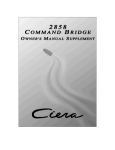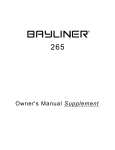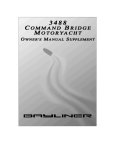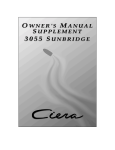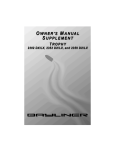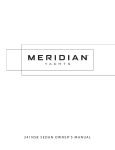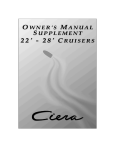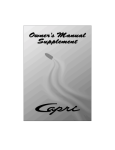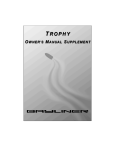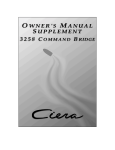Download Bayliner Ciera Specifications
Transcript
Engine Serial Number: Hull Identification Number: Hull Identification Number The Hull Identification Number (HIN) is located on the starboard side of the transom. Be sure to record the HIN (and the engine serial numbers) in the space provided above. Please refer to the HIN for any correspondence or orders. HIN LOCATION © 2000 Bayliner Marine Technical Publications. All rights reserved. No part of this publication may be reproduced, stored in any retrieval system, or transmitted in any form by any means, electronic, mechanical, photocopying, recording or otherwise, without prior written permission of Bayliner. Printed in the United States of America. General Notes The material in this document is for information only and is subject to change without notice. While reasonable efforts have been made in the preparation of this document to assure its accuracy, Bayliner assumes no liability resulting from errors or omissions in this document, or from the use of information contained herein. Due to our commitment to product improvement, Bayliner reserves the right to make changes in the product design, specifications, and equipment at any time without notice or obligation. Illustrations and/or photos may show optional equipment. All Bayliner products meet or exceed USCG (Unites States Coast Guard) and/or NMMA (National Marine Manufacturer’s Association) construction standards. Manufactured with 1,1,1 Trichloroethane, a substance which harms public health and environment during the manufacturing process by destroying ozone in the upper atmosphere. Proprietary Rights This document discloses subject matter in which Bayliner has proprietary rights. The information and design disclosed herein were originated by and are the property of Bayliner. Neither receipt nor possession thereof confers or transfers any right to reproduce, copy, alter or disclose the document or any part thereof, any information contained therein, or to construct boats or any item from it, except by written permission from or written agreement with Bayliner. This document is to be returned upon request to Bayliner. CONTENTS Chapter 1: Welcome Aboard! 1 1 1 2 2 3 3 Dealer Service Boating Experience Engine/Accessories Guidelines Qualified Maintenance Special Care For Moored Boats Safety Standards Hazard Boxes & Symbols 12 13 13 VHF Radio (LX models only) 13 Compass (LX models only) 13 Depth Finder (LX models only) 13 13 14 9 10 Dimensions and Tank Capacities Layout View Hull Hardware Transom Hardware Deck Hardware Cockpit Hardware Helm Hardware Boat Lifting Anchor Windlass (Available Through US Marine Parts) Electrical System 12 Volt DC System 10 10 10 11 Fuses and Circuit Breakers Batteries Battery Switch Battery Charger (LX models only) Navigation and Interior Lights Appliances Propulsion 14 Engine 14 Fuel System 14 Fuel Fill and Vent: 14 Fuel Filters: 14 Anti-siphon Valve: Chapter 2: Features & Systems 4 4 4 5 5 6 7 8 8 Audio Equipment Navigation & Communication Equipment 15 15 16 16 Bilge Blower Power Trim and Tilt Trim Tabs Bilge Pumps 17 Autofloat Switches 18 Freshwater Systems 18 Water Heater (LX Models Only) 19 Transom Shower (LX Models Only) 19 Raw Water System 19 Seacocks 19 Raw Water Strainers 20 Marine Head With Holding Tank 20 Macerator (Option) 21 22 Air Conditioning System (LX Option) Sink and Shower Drains 22 Shower Sump Pump System 22 23 Canvas Top Installation Warning Label Locations Chapter 3: Electrical Routings 24 Hull Harnesses Routings 24 25 26 27 28 AC Hull Harness Routings DC Hull Harness Routings Battery Cable Routings Bonding Harness Routing Deck Harness Routings Chapter 4: Wiring Schematics 29 30 31 DC Electrical System AC Electrical System, Single Shore Power AC Electrical System, Dual Shore Power (Air Cond. Option) Limited Warranty 32 32 32 What Is Not Covered Other Limitations Your Obligation CONTENTS Chapter 1: Welcome Aboard! 1 Chapter 1: Welcome Aboard! This owner’s manual supplement provides specific information about your boat that is not covered in the owner’s manual. Study the owner’s manual and this supplement carefully, paying particular attention to the Limited Warranty in this supplement. Keep the owner’s manual and this supplement on your boat in a secure, yet readily available place. De a le r S er v i ce Make sure you receive a full explanation of all systems from the selling dealer before taking delivery of your boat. Your selling dealer is your key to service. If you experience any problems with your new boat, immediately contact the selling dealer. If for any reason your selling dealer is unable to help, you can call us direct on our customer service hotline: 360-435-8957 or send us a FAX: 360-403-4235. B o a t in g E xp e r i en c e If this is your first boat or if you are changing to a type of boat you are not familiar with, for your own comfort and safety, you must obtain handling and operating experience before assuming command of the boat. Take one of the boating safety classes offered by the U.S. Power Squadrons or the U.S. Coast Guard Auxiliary. For more course information, including dates and locations of upcoming classes, contact the organizations directly: • U.S. Power Squadrons: 1-888-FOR-USPS (1-888-367-8777) or on the Internet at: http://www.usps.org • U.S. Coast Guard Auxiliary: 1-800-368-5647 or on the Internet at: http://www.cgaux.org Outside the United States, your selling dealer, national sailing federation or local boat club can advise you of local sea schools or competent instructors. ! WARNING! CONTROL HAZARD! A qualified operator must be in control of the boat at all times. DO NOT operate your boat while under the influence of alcohol or drugs. E n g in e / Ac ce s s o r ie s G u id e li n e s Your boat’s engine and accessories were selected to provide optimum performance and service. Installing a different engine or other accessories will cause unwanted handling characteristics. Should you choose to install a different engine or to add accessories that will affect the boat’s running trim, have an experienced marine technician perform a safety inspection and handling test before operating your boat again. Please be advised that certain modifications to your boat can result in cancellation of your warranty protection. Always check with your dealer before making any modifications to your boat. The engine and accessories installed on your boat come with their own operation and maintenance manuals. Read and understand these manuals before operating the engine and accessories. NOTICE When storing your boat refer to your engine’s operation and maintenance manuals. Ciera 2655 Sunbridge • Owner’s Manual Supplement 2 Chapter 1: Welcome Aboard! Q u al if ie d M ai n te n a n c e Failure to maintain your boat’s systems as designed could violate the laws in your jurisdiction and will expose you and other people to the danger of bodily injury or accidental death. Follow the instructions provided in the owner’s manual, this owner's manual supplement, the engine owner’s manual and all accessory instruction sheets/manuals included in your boat’s owner’s packet. ! WARNING! To maintain the integrity and safety of your boat, only qualified personnel should perform maintenance on, or in any way modify: The steering system, propulsion system, engine control system, fuel system, environmental control system, electrical system or navigational system. S p e c ia l Ca r e F o r Mo o r e d B o a ts If moored in saltwater or fresh water, your boat will collect marine growth on its hull bottom. This will detract from the boat’s beauty, greatly affect its performance and may damage the gelcoat. • Periodically haul the boat out of the water and scrub the hull bottom with a bristle brush and a solution of soap and water. NOTICE • To help seal the hull bottom and reduce the possibility of gelcoat blistering on moored boats, we recommend the application of an epoxy barrier coating, such as INTERLUX, Interprotect 2000E/2001E. The barrier coating should be covered with several coats of anti-fouling paint. • Many states regulate the chemical content of bottom paints in order to meet environmental standards. Check with your local dealer about recommended bottom paints, and about the laws in effect in your area. Ciera 2655 Sunbridge • Owner’s Manual Supplement Chapter 1: Welcome Aboard! 3 S a fe t y Sta n d ar d s Your boat’s mechanical and electrical systems were designed to meet safety standards in effect at the time it was built. Some of these standards were mandated by law, all of them were designed to insure your safety, and the safety of other people, vessels and property. In addition to reading this owner’s manual supplement, read the owner’s manual and all accessory instruction sheets for important safety standards and hazard information. ! DANGER! DANGER PERSONAL SAFETY HAZARD! Do not allow anyone to ride on parts of the boat not designated for such use. Sitting on seat backs, lounging on the forward deck, bow riding, gunwale riding or occupying the transom platform while underway is especially hazardous and will cause personal injury or death. H a z a r d B o x es & S y m b o l s The hazard boxes and symbols shown below are used throughout this supplement to call attention to potentially dangerous situations which could lead to either personal injury or product damage. Read these warnings carefully and follow all safety instructions. ! DANGER! This box alerts you to immediate hazards which WILL cause severe personal injury or death if the warning is ignored. ! WARNING! This box alerts you to hazards or unsafe practices which COULD result in severe personal injury or death if the warning is ignored. ! CAUTION! This box alerts you to hazards or unsafe practices which COULD result in minor personal injury or cause product or property damage if the warning is ignored. NOTICE This box calls attention to installation, operation or maintenance information, which is important to proper operation but is not hazard related. EXPLOSION HAZARD! OPEN FLAME HAZARD! HOT HAZARD! ELECTRICAL HAZARD! PERSONAL INJURY & FALLING HAZARD! Ciera 2655 Sunbridge ROTATING PROPELLER HAZARD! • Owner’s Manual Supplement 4 Chapter 2: Features & Systems Chapter 2: Features & Systems D i m e n si o n s a n d Ta nk C a pac i ti e s Overall Length Bridge Clearance Beam Draft (Drive Up) Fuel Capacity (gal) Freshwater Capacity (gal.) Waste Holding Tank Capacity (gal.) 27’0" 6’9" 9’1" 1’5" 89 30 20 L a yo u t Vie w mid ship cleats cooler niche under lounge stowage beneath table folding transom seat transom door stowage stove double mid-berth fold down TM SunChaiser lounge sink steps trash in bin engine hatch sink w/ storage under stowage helm under bench helm seat seat head quick drop table storage converts under to larger forward v-berth berth w/ stowage under mid ship cleats Hu l l Ha r d w ar e FUEL AND WASTE VENTS AFT BILGE PUMP STORAGE DRAIN STBD. HULLSIDE BOW EYE COCKPIT DRAINS FWD. BILGE SHOWER PUMP SUMP HEAD SINK WATER TANK VENT PORT HULLSIDE ANCHOR LOCKER DRAIN AIR COND. OVERBOARD (OPTION) Ciera 2655 Sunbridge AIR COND. DRAIN (OPTION) GALLEY DRAIN • Owner’s Manual Supplement COCKPIT DRAINS Chapter 2: Features & Systems 5 Tra n s o m H a r d wa r e TRANSOM TRIM TAB (TYPICAL) STERN EYE (TYPICAL) GARBOARD DRAIN MACERATOR DISCHARGE (OPTION) RETRACTABLE BOARDING LADDER D e c k H a r d w ar e FORE DECK HARDWARE AFT DECK HARDWARE AFT FWD. BOW NAVIGATIONAL LIGHT (TYPICAL) CLEAT ANCHOR ROLLER ROPE CHOCK (TYPICAL) DECK PIPE WATER FILL GRAB HANDLES Ciera 2655 Sunbridge WASTE DECK FUEL PUMP-OUT CLEAT FILL FITTING (TYPICAL) • Owner’s Manual Supplement 6 Chapter 2: Features & Systems Co c k p it H a rd w a r e VIEW OF FORWARD COCKPIT FOREDECK ACCESS THROUGH OPENING CENTER SECTION OF WINDOW FWD. CABIN DOOR HELM AREA PORT LOUNGE SEAT HELM SEAT CUP HOLDERS STORAGE AREA AND BATTERY SWITCH ACCESS STBD. VIEW OF AFT COCKPIT (LOOKING AFT) PORT TRANSOM DOOR Ciera 2655 Sunbridge AFT COCKPIT BENCH SEAT • Owner’s Manual Supplement TRANSOM STORAGE BASE FOR COCKPIT TABLE BILGE ACCESS HATCH Chapter 2: Features & Systems 7 H e lm H ar d w a r e INSTRUMENT PANEL FUEL GAUGE VOLTMETER HORN SWITCH BLOWER SWITCH TRIM TAB GAUGE FWD. & AFT BILGE PUMP SWITCHES IGNITION ACCESSSORY SWITCHES TEMPERATURE DEPTH FINDER OIL PRESSURE GAUGE GAUGE GAUGE ACCESSORY SWITCH PANEL COCKPIT LIGHTS ANCHOR LIGHTS TACHOMETER NAVIGATION LIGHTS SPEEDOMETER WIPER SWITCH VHF RADIO TRIM TAB SWITCHES WINDLASS CONTROLS (OPTION) INSTRUMENT PANEL 12 VOLT ADAPTER TILT STEERING SWITCH PANEL CIRCUIT BREAKERS Ciera 2655 Sunbridge • Owner’s Manual Supplement 8 Chapter 2: Features & Systems Bo a t L i ft in g • Always follow the lift equipment’s instructions and requirements. • If bilge water is present, pump water out of the bilge areas before lifting your boat. Excessive amounts of bilge water can shift and change the balance of the load. • When lifting your boat, always position the lifting slings at the fore and aft sling label positions. CAUTION! ! PRODUCT OR PROPERTY DAMAGE HAZARD! When lifting any boat always use a spreader bar. The spreader bar must be equal to the width of the boat at the lifting point. Always secure the slings to one another to prevent the forward sling from sliding up along the forefoot of the boat. Lifting sling positions shown on this drawing are typical for port and starboard sides. FO TYPICAL TWO LABELS PER SIDE 3 1/2" R EF O O T 42 1/2" A n c h o r W in d l as s ( Av a il ab l e T h r o u g h U S M a r in e P a r ts ) An anchor windlass is available through US Marine parts. Read the manufacturer’s instruction manual, before using the anchor windlass for the first time. • The windlass can be controlled from a switch at the helm or from the deck foot switches. • Verify that the windlass breaker is activated before using the anchor windlass. • To haul the anchor, use engine power (not the windlass) to move the boat to, and directly above, the anchor. Activate the windlass to disengage the anchor from the bottom by pulling it straight up. VIEW OF FOREDECK FWD. WINCH “UP” SWITCH (TYPICAL) WINCH “DOWN” SWITCH (TYPICAL) ANCHOR WINDLASS NAVIGATIONAL LIGHT (TYPICAL) ROPE CHOCK (TYPICAL) ANCHOR ROLLER ! CAUTION! PRODUCT DAMAGE HAZARD! Do not pull the boat to the anchor using the windlass or continue to operate the windlass if it has stalled or is overloaded. Ciera 2655 Sunbridge • Owner’s Manual Supplement Chapter 2: Features & Systems 9 E le c t r ic a l S y st e m Thoroughly read and understand this section and the electrical sections of the owner’s manual and all accessory manuals included in your boat owner’s packet. Electrical routing drawings are provided in Chapter 3 of this supplement, wiring schematics in Chapter 4. ! DANGER! EXTREME FIRE, SHOCK & EXPLOSION HAZARD! • To minimize the risks of fire and explosion, NEVER install knife switches or other arcing devices in the fuel compartments. • NEVER substitute automotive parts for marine parts. Electrical, ignition and fuel system parts were designed and manufactured to comply with rules and regulations that minimize risks of fire and explosion. • DO NOT modify the electrical systems or relevant drawings. • Only qualified personnel should install batteries and/or perform electrical system maintenance. • Insure that all battery switches are turned OFF before performing any work in the engine spaces. ! WARNING! FIRE, OPEN FLAME & EXPLOSION HAZARD! • Fuel fumes are heavier than air and will collect in the bilge areas where they can be accidently ignited. Visually and by smell (sniff test), check the engine and fuel compartments for fumes or accumulation of fuel. ALWAYS operate the bilge blowers for at least four minutes prior to engine starting, electrical system maintenance or activation of electrical devices. • Minimize the danger of fire and explosion by not exposing batteries to open flame or sparks. It is also important that no one smoke anywhere near the batteries. ! CAUTION! SHOCK & ELECTRICAL SYSTEM DAMAGE HAZARD! NEVER disconnect the battery cables while the engine is running since it can cause damage to your boat’s electrical system components. NOTICE Electrical connections are prone to corrosion. To reduce corrosion caused electrical problems, keep all electrical connections clean and apply a spray-on protectant that is designed to protect connections from corrosion. NOTICE Since the batteries on your boat were dealer-installed, the battery switch positions listed above may vary. Make sure you’ve had a full explanation of battery switch operation from your selling dealer. Ciera 2655 Sunbridge • Owner’s Manual Supplement 10 Chapter 2: Features & Systems 1 2 Vo lt D C S y st e m Fuses and Circuit Breakers The engine is protected by a large circuit breaker located on the engine. The accessories are protected by circuit breakers on the battery switch panel and by the accessory circuit breakers located below the steering wheel. Wires are color-coded to indicate which accessory each circuit breaker services. Some items, such as radios and bilge pumps, may be fused individually at the unit. Autofloat switches are fused at the battery. Batteries The batteries supply electricity for lights, accessories and engine starting. The electrical section of Chapter 8, in the Owner’s Manual, provides battery care and maintenance instructions. POSITION 1 ACTIVATES BATTERY 1 BATTERY SWITCH LOCATED BEHIND HELM SEAT IN STORAGE AREA POSITION BOTH ACTIVATES BOTH BATTERIES POSITION 2 ACTIVATES BATTERY 2 OFF POSITION AFT BILGE STBD. BATTERY INSTRUMENT PANEL Battery Switch AFT The battery switch (located behind the helm seat in the storage area) has four (4) positions (see upper photograph on right); PORT BATTERY VOLTMETER GAUGE • Position 1 - Battery 1 provides power for engine starting and accessories. Battery 1 (only) will be charged by the engine alternator when the engine is running at high idle or faster. • Position 2 - Battery 2 provides power for engine starting and accessories. Battery 2 (only) will be charged by the engine alternator when the engine is running at high idle or faster. • Position "BOTH" - If batteries are low, provides power for engine starting from both batteries. The BOTH position also allows the charging of both batteries by the engine alternator when the engine is running at high idle or faster. • The battery switch should be switched to the OFF position whenever the boat is left unoccupied for long periods of time. Table 1: Battery Switch Positions Battery Switch Position Engine Starting Accessories and Lights POSITION 1 Battery 1 Provides Starting Power POSITION 2 BOTH POSITION Ciera 2655 Sunbridge Engine Alternator Battery Charger Battery 1 Provides Power for Accessories and Lights Charges Battery 1 Charges BOTH Batteries Battery 2 Provides Starting Power Battery 2 Provides Power for Accessories and Lights Charges Battery 2 Charges BOTH Batteries BOTH Batteries Provide Starting Power BOTH Batteries Provide Accessory Power (not advised unless engine is running) Charges BOTH Batteries Batteries will NOT Charge Properly • Owner’s Manual Supplement Chapter 2: Features & Systems Battery Charger (LX models only) Your boat may be equipped with a battery charger located on the forward engine room bulkhead. You must read and understand the battery charger manual before using the charger. • The battery charger will charge the boat’s batteries whenever the boat is plugged into 120 volt shore power. • For proper charging; turn the battery switch to any position except BOTH. 11 BATTERY CHARGER TO PORT BATTERY TO STBD. BATTERY TO HOT WATER TANK CAUTION! ! • The battery charging systems (alternator and battery charger) are designed to charge conventional lead-acid batteries. Before installing gel-cell (or other new technology) batteries, read and follow the battery charger’s operating instructions. • Loose battery cable connections will damage your battery charger and your boat Shore Power/110 Volt AC System (LX models only) TYPICAL SHORE POWER RECEPTACLE ! CAUTION WATER HEATER DAMAGE HAZARD! DO NOT energize the AC water heater electrical circuit until the heater is completely filled with water. Even momentary operation in a dry tank will damage the heating elements. Warranty replacements will not be made on elements or tank damaged in this manner. The tank is full if water flows from the tap when the hot water is turned on in the galley. AIR COND. (OPTION ONLY) TYPICAL AC POWER PANEL ! SHORE POWER INLETS PORT SIDE OF DECK DANGER! FIRE, EXPLOSION & SHOCK HAZARD! • DO NOT alter shore power connectors and use only compatible connectors. • Before connecting or disconnecting the shore power cord to your boat, verify all breakers and switches on the AC master panel are turned OFF. • To prevent shock or injury from an accidental dropping of the “hot” cord into the water, ALWAYS attach the shore power cord to the boat inlet first; then to the dockside connection. When disconnecting from shore power, disconnect the shore power cord from the dockside connection first. • NEVER leave a shore power cord connected to the dockside connection only. • Only use shore power cords approved for marine use. NEVER use ordinary indoor or outdoor extension cords that are not rated for marine use. Ciera 2655 Sunbridge • Owner’s Manual Supplement 12 Chapter 2: Features & Systems ! CAUTION! FIRE, SHOCK & ELECTRICAL SYSTEM DAMAGE HAZARD! • NEVER connect dockside power to your boat outside North America unless you have purchased the international electrical conversion option. • The simultaneous use of several AC components can result in an overloaded circuit. It may be necessary to turn off one or more accessories in order to use another accessory. • Use double insulated or three-wire protected electrical appliances whenever possible. • Periodically check the shore power cord(s) for deterioration or damage. Damaged or faulty cords should NEVER be used since the danger of fire and electrical shock exists. • DO NOT pinch shore power cords in doors or hatches, or coil the shore power cord too tightly since these situations can generate enough heat to result in a fire. • If a shore power cord should accidently become immersed in water, THOROUGHLY dry the blades and contact slots before reusing. NOTICE Some dockside installations may be rated less than 30 amps, therefore, you may need to purchase lower amp adapters. Whenever a lower amp adapter is used, however, there will be a corresponding drop in supplied power from the dockside system. Connecting to Shore Power 1. Monitor the AC panel’s polarity indicator lights (next to the line 1 and line 2 master breakers) as follows: • A GREEN light illuminating after the power cord is plugged into the boats external power receptacle indicates acceptable electrical power in which you may energize the main breaker switches. • A RED light, however, indicates reversed polarity, which could cause electrical system damage and possibly electrical shock injuries. In this case, DO NOT energize the main breaker switches (see warning below). 2. Activate the AC system by turning the main ship/shore breaker to the “DOCKSIDE” position. 3. Turn ON the master breakers and individual component breakers as required. ! WARNING! SHOCK & ELECTRICAL SYSTEM DAMAGE HAZARD! • Monitor the polarity indicator lights EVERY TIME you connect to shore power. • When connecting to shore power and you encounter a reversed polarity light (RED colored), DO NOT energize the main breaker switches. Instead, IMMEDIATELY disconnect the shore power cord (ALWAYS from the dockside receptacle first) and notify marina management. NOTICE The voltage on each line can be read by setting the voltmeter selector switch. A u d i o E q u i p m e nt The audio equipment installed on your boat has separate manuals (included in your boat’s owner’s packet) that explains its operating procedures in detail. NOTICE AM radio reception may be impaired in areas where reception is limited or anytime the engine is running. Ciera 2655 Sunbridge • Owner’s Manual Supplement Chapter 2: Features & Systems 13 N a v ig a t io n & C o m m u n ic a t io n E q u ip m e n t The owner’s packet contains operation manuals for all navigation & communication equipment installed on your boat. Thoroughly read and understand these manuals before using these systems. Additionally, read the warnings below carefully and follow all safety instructions. VHF Radio (LX models only) Your boat may include a VHF (Very High Frequency) radio at the helm. The VHF radio can be used to access weather reports, summon assistance or contact other vessels as permitted by the FCC (Federal Communications Commission). Be sure to contact the FCC for licensing, rules and regulations concerning VHF radio usage. Compass (LX models only) NOTICE Compass accuracy can be affected by many factors. Have a qualified technician calibrate your compass. Make sure the technician gives you a deviation card which shows the corrections to apply in navigational calculations. Keep a copy of the deviation card at the helm. Depth Finder (LX models only) ! WARNING! • DO NOT use the depth finder as a navigational aid to prevent collision, grounding, boat damage or personal injury. • When the boat is moving, submerged objects will not be seen until they are already under the boat. Bottom depths may change too quickly to allow time for the boat operator to react. If you suspect shallow water or submerged objects, operate the boat at very slow speeds. N a v ig a t io n a n d In t er i o r L i g h ts Read and understand the navigation light section of the owner’s manual. The navigation and interior lights installed on your boat are of top quality, but you should be aware that failure may periodically occur for a variety of reasons: • There may be a tripped breaker - reset the breaker switch. • The bulb may be burned out - carry spare bulbs for replacement. • A wire may be damaged or may have come loose - repair as required. • The bulb base may be corroded - clean the base and coat it with non-conductive electrical lubricant. ! CAUTION! • Avoid the storage of gear where it would block navigation lights from view. • Be conservative in the use of battery power. Prolonged operation of cabin interior lights (overnight) will result in a drained battery. A p p l ia n ce s All appliances installed on your boat come with their own manuals that contain detailed operating instructions and important safeguards. Thoroughly read and understand these manuals before operating your boat’s appliances. • Make sure the AC breaker is activated for the appliance you wish to turn on. NOTICE Always keep an approved ABC-type fire extinguisher in galley area. Ciera 2655 Sunbridge • Owner’s Manual Supplement 14 Chapter 2: Features & Systems Alcohol/Electric Stove Your boat may feature an alcohol stove (DX models) or an alcohol/electric stove (LX models). Before using your stove, read and understand the manufacture’s manual as well as these instructions. ! CAUTION! To prevent overheating which can destroy the electric burner elements, never attempt to use both alcohol and electric burners simultaneously (LX models only). ! WARNING! EXPLOSION, SCALDING & FIRE HAZARD! • DO NOT operate the stove unless you have read the owner’s manual from the manufacturer. Use these instructions only as a reminder. • Always keep an approved ABC-type fire extinguisher in galley area. • Any non-cooking devices on or near your stove during operation are potential fire hazards! • Do not operate the stove while underway. • Open flame cooking appliances consume oxygen, this can cause asphyxiation or death. Maintain open ventilation. P r o p u ls i o n Engine The owner’s packet contains detailed engine operation and maintenance manuals. Be sure to read and understand these manuals before operating or performing maintenance to the engine. F u e l S ys t e m STBD. Fuel Fill and Vent: The fuel fill is located on the starboard aft deck. The fuel fill fitting is marked “GAS”. The fuel tank vent is located below the fuel fill. If you experience difficulty filling the fuel tank, check to see that the fuel fill and vent lines are free of obstructions and kinks. DECK FITTING FUEL FILL AFT Fuel Filters: All tanks are equipped with a fine mesh screen filter on the fuel pickup tube (located inside or on the outside of the tank) to the fuel line fitting. In addition, when supplied by the engine manufacturer, a filter is installed on the engine. Fuel filters should be replaced periodically to ensure they remain clean and free of debris. Consult your selling dealer or local marina concerning fuel additives that help to prevent fungus or buildup in your fuel tank. Anti-siphon Valve: Your boat is equipped with an anti-siphon valve, which is an integral part of the barb fitting on the fuel tank where the neoprene fuel line attaches. The valve is spring loaded and is opened by fuel pump vacuum. These valves will prevent fuel from siphoning from the tank in the event of a fuel line rupture. Ciera 2655 Sunbridge • Owner’s Manual Supplement FUEL VENT FITTING FUEL FILL HOSE FUEL VENT HOSE . BD ST T AF FUEL TANK ENGINE COMPARTMENT Chapter 2: Features & Systems 15 NOTICE If an engine running problem is diagnosed as fuel starvation, check the anti-siphon valve. In the event the valve is stuck or clogged, it should be changed or replaced while the engine is shut down. Under NO circumstances should the anti-siphon valve be removed, except in an emergency. WARNING! ! FIRE/EXPLOSION HAZARD - It is very important that the fuel system be inspected thoroughly the first time it is filled and at each subsequent filling. For your safety and the safety of your passengers, the fueling instructions in the Owner’s Manual must be carefully followed. ! CAUTION Avoid the storage or handling of gear near the fuel lines, fittings and tank. Bi lg e B lo w e r The bilge blower removes fumes from the engine compartment and draws fresh air into the compartment through the deck vents. To ensure fresh air circulation, operate the bilge blower for at least four minutes before starting the engine, during starting, and while operating the boat below cruising speed. BILGE BLOWER SYSTEM TRANSOM STBD. FUEL TANK ENGINE COMPARTMENT BLOWER BLOWER HOSES, TO/FROM DECK LOUVERS ! WARNING! EXPLOSION HAZARD! • Operation of the blower system is not a guarantee that explosive fumes have been removed. If you smell fuel, DO NOT start the engine. If the engine is already running, IMMEDIATELY shut OFF the engine and all electrical accessories and investigate. • DO NOT obstruct or modify the ventilation system. P o w er Tr im a nd Til t The stern drive on your boat is equipped with power trim and tilt. The engine operation manual in your owner’s packet describes proper power trim and tilt operation. TRIM “UP/DOWN” CONTROL SWITCH TILT “UP/DOWN” CONTROL SWITCH SHIFTER/THROTTLE CONTROL LEVEL Ciera 2655 Sunbridge TRIM/TILT GAUGE • Owner’s Manual Supplement 16 Chapter 2: Features & Systems Tr im Ta b s The trim tabs may be used to help keep your boat level at cruising speeds. The trim tabs are controlled by two rocker switches at the helm. Before using the trim tabs read and understand the trim tab operation manual included in your boat’s owner’s packet. Observe the following: • Once cruising speed is reached, the port or starboard trim switch may be used (one at a time) to level the boat. Perform trim tab adjustment with several short touches to the switch rather than one long one. After each short touch allow several seconds for the hull to react. • The trim tab hydraulic fluid reservoir is located in the engine compartment. The fluid level must be checked periodically (at least once a year) and refilled as necessary. TRIM TAB ROCKER SWITCHES TRIM TAB COMPONENTS TRANSOM TRIM TAB (TYPICAL) WARNING! ! LOSS OF CONTROL HAZARD! • Improper use of trim tabs may cause loss of control! DO NOT use trim tabs in a following sea as they may cause broaching or other unsafe handling characteristics. • NEVER allow anyone unfamiliar with trim tabs to operate them. • DO NOT use trim tabs to compensate for excessive unequal weight distribution. B i l g e P u m ps Your boat is equipped with two impeller-type bilge pumps. The bilge pumps are automatically controlled by float switches (see "Autofloat Switches" on the next page). The bilge pumps can also be controlled by switches on the dash. FWD BILGE PUMP LOCATION STBD. AFT BILGE PUMP LOCATION STBD. THRU-HULL AFT FWD. AFT BILGE PUMP & FLOAT SWITCH THRU-HULL FWD BILGE PUMP & FLOAT SWITCH NOTICE Discharge of oil, oil waste or fuel into navigable waters is prohibited by law. Violators are subject to legal action by the local authorities. Ciera 2655 Sunbridge • Owner’s Manual Supplement Chapter 2: Features & Systems 17 Bilge Pump Testing Bilge pumps must be tested often to verify that they are working properly. To manually test a bilge pump’s operation, activate the dash-mounted switch and verify that bilge water is pumped overboard. If bilge water is present and the pump motor is running but not pumping, inspect the discharge hose for a kink or collapsed area. If no problems are found, check the bilge pump housing for clogging debris as follows: Bilge Pump Cleaning: BILGE PUMP 1. Remove the power cartridge: COMPONENTS a. Lift the tab while rotating the fins counterclockwise. TAB b. Lift out the power cartridge. c. Clear the outer housing of debris. 2. Reinstall the power cartridge: “O” RING a. Make sure the “O” ring is properly seated. b. Coat the “O” ring with a light film of vegetable or mineral oil. FIN c. Align the two cams on either side of the power carOUTER tridge with the two slots on the outer housing and HOUSING press the power cartridge into the housing while twisting clockwise. d. To ensure proper reinstallation of the power cartridge, attempt to twist the fins counterclockwise without lifting the tab: The cartridge should stay in place. LIGHT FILM OF OIL CAM (TYPICAL) POWER CARTRIDGE SLOT (TYPICAL) Autofloat Switches Automatic bilge pumps use electromagnetic float (autofloat) switches to automatically activate the pump whenever bilge water accumulates above a preset level. One autofloat switch is mounted next to the bilge pump it activates, and is wired directly to the battery so it will normally function even when the boat is completely shut down and left unattended. Autofloat switches must be tested often for proper operation as follows: Float Switch Test: 1. Push the float switch test button up to activate the bilge pump. If the pump does not turn on, check the inline fuse. If the fuse is good but the switch doesn’t work, it may indicate a bad switch or possibly a low battery. 2. Push the test button all the way down to return the float switch back into the auto mode. FLOAT SWITCH TESTING FLOAT SWITCH TEST BUTTON ! FLOAT UP - TEST MODE FLOAT DOWN - AUTO MODE BILGE PUMP SHOULD TURN ON BILGE PUMP SHOULD TURN OFF CAUTION! When test is completed on a float switch, you must push the test button all the way down to the auto position to turn the switch back into auto mode! Ciera 2655 Sunbridge • Owner’s Manual Supplement 18 Chapter 2: Features & Systems F r e sh w a te r S y st e m s WATERLINE ROUTING (DX MODELS ONLY) WATERLINE ROUTING (LX MODELS ONLY) WATERLINE TO GALLEY WATERLINE TO HEAD WATER TANK WATER FILTER TO GALLEY WATER FILL FITTING TO HEAD AFT PORT DECK AFT WATER TANK TRANSOM SHOWER WATER FILTER WATER PUMP GALLEY FAUCET HOT WATER LINE PORT TRANSOM COLD WATER LINE WATER PUMP SWITCH WATER PUMP WATER HEATER Your boat is equipped with a pressure-demand (potable) freshwater system. These pressure type (demand) systems operate when the water pump switch (located behind the galley sink, see illustration above) is in the ON position. • The water pump’s DC breaker must be turned ON to use freshwater. • The water pump’s DC breaker should be turned OFF when any of the following occurs: 3 When the boat is not in use. 3 Whenever the water tank is empty. • The water tank fill fitting is located on the aft port deck, (see illustration on right). • Drain the freshwater system in winter months and when not in use to prevent damage and to keep stored water from becoming stagnant and distasteful. Should it become necessary to disinfect the freshwater system, ask your dealer about treatments available for your boat’s system. • The water filter, located on the water pump in the bilge, should be inspected and cleaned often. • The water tank is located on the port side of the bilge. Water Heater (LX Models Only) • Your boat may be equipped with a water heater. The water heater is located on the aft port side of the bilge. • The water heater is connected to the AC power system, therefore, you must verify that the water heater breaker on the AC panel is turned ON before water will be heated. (SEE CAUTION BELOW). • Read the manufacturer’s instruction manual in your boat’s owner’s packet and observe the following warnings: ! WARNING! HOT HAZARD! Water heated by the water heater will reach temperatures high enough to scald the skin. ! CAUTION! WATER HEATER DAMAGE HAZARDS! • DO NOT energize the AC water heater electrical circuit until the heater is completely filled with water. Even momentary operation in a dry tank will damage the heating elements. Warranty replacements will not be made on elements or tank damaged in this manner. The tank is full if water flows from the tap when the hot water is turned on in the galley. • The water heater must be drained and the power turned OFF when the possibility of freezing exists. Ciera 2655 Sunbridge • Owner’s Manual Supplement Chapter 2: Features & Systems 19 Transom Shower (LX Models Only) Your boat may feature a freshwater transom shower. It is located on the aft port side of the cockpit. The water pump switch MUST be activated before using the transom shower. Be sure to read the manufacturer’s operating instructions, provided in your boat’s owner’s packet. Ra w Wa t e r S y s te m Seacocks Seacocks are valves which are typically used to manage the intake of raw water through the hull below the water line (raw water intake seacocks). Seacocks may also be used to discharge waste or water through the hull below the water line (discharge seacocks). Seacocks are controlled by a 90º lever and are used on your boat in the following raw water intake/discharge systems: Engine, (optional) air conditioning system and marine head (toilet) system. ! TYPICAL RAW WATER INTAKE SEACOCK COMPONENTS 90º SEACOCK LEVER HULL SECTION SEACOCK GASKET INTAKE STRAINER CAUTION! SYSTEM DAMAGE HAZARD! Verify that the system’s seacock is OPEN before the system is started and keep the seacock open until the system is shut off. Close seacocks whenever the systems will not be used for long periods of time. Raw Water Strainers Raw water strainers are used in water pickup systems to filter incoming raw water. The typical layout is one strainer for each of the following: Engine, and optional air conditioning system. Raw water strainers are located near raw water intake valves (seacocks) and should be checked every time you use your boat for leaks and/or debris. If debris is found, clean the raw strainer as follows: 1. Make sure the component/system (engine, air conditioning system, etc.) that the strainer is connected to is turned OFF. 2. Close the seacock that sends raw water to the strainer you are about to clean. The seacock must remain closed until the strainer is completely reassembled. 3. Take apart the raw water strainer. 4. Remove debris. 5. Flush strainer with water. 6. Reassemble the raw water strainer. 7. Open the seacock and check for leaks around the strainer. If no leaks are found, you may activate the component or system. ! CAUTION! • FLOODING HAZARD! The seacock that sends raw water to the strainer must be CLOSED before disassembling the raw water strainer to prevent the boat from taking on water through the raw water strainer assembly. Keep the seacock CLOSED until the raw water strainer is completely reassembled. • SYSTEM DAMAGE HAZARD! After reassembling the raw water strainer, verify that the seacock valve is OPEN before energizing the component/system. Ciera 2655 Sunbridge • Owner’s Manual Supplement 20 Chapter 2: Features & Systems Marine Head With Holding Tank ST BD . A FT Your boat comes equipped with a marine head (toiMARINE HEAD SYSTEM let) and waste holding tank system. Be sure to read the manufacturer’s operation and maintenance HEAD PICKUP LOCATED BELOW ENTRY STEP manual (included in your boat’s owner’s packet). STB D. • The marine head installed on your boat uses seawater to flush waste from the toilet. The seawater intake valve (seacock) is located under the entry steps in the cabin. • Waste is routed directly from the head to the holding tank. • The holding tank is plumbed to a fitting on the deck for dockside pump-out. WASTE PUMP HOLDING TANK OUT FITTING VENT • You can determine the content level of the holding tank by looking at the tank located on the starboard side of the bilge. Empty the holding tank at every opportunity. HOSE FROM HOLDING TANK HOLDING TO WASTE • If you are unable to pump water into the bowl, MARINE HEAD VENT HOSE TANK PUMP OUT FITTING the probable cause is debris in the pump diaphragm. To remedy this, shut off the seawater intake valve (seacock) and dismantle the pump. The pump is generally held together with six screws (the design is simple and the problem will be obvious when the pump body is split open). To winterize the head, shut off the intake seacock AFT and pump until the bowl is dry. Remove the drain plug in the base and pump again to remove all of the water. Do not fill the bowl with anti-freeze. The intake seacock should be left closed while the boat is underway or whenever the boat is left moored in the water. Operating the manual flush marine head: 1. Open the head’s seawater intake valve (seacock). 2. Before using the head, pump enough water into the bowl to wet the sides. After use, pump until the bowl is clean. Continue pumping a few more times to clean the lines. If excess waste causes the water to rise in the bowl, stop pumping until the water recedes. Macerator (Option) Before using the macerator option to pump waste directly into the water (where regulations permit) you must: • Open the underwater discharge seacock located on the starboard transom. • Set the y-valve to direct the waste to the macerator. The macerator switches must be pressed simultaneously for pumping to occur. MACERATOR SYSTEM MACERATOR TO WASTE PUMP OUT DECK FITTING TO MACERATOR HELM SHIFT/THROTTLE LEVER Y-VALVE TO UNDERWATER DISCHARGE SEACOCK MACERATOR SWITCH NOTICE Check with local authorities for regulations regarding the legal use of marine head systems. Ciera 2655 Sunbridge • Owner’s Manual Supplement Chapter 2: Features & Systems 21 A i r C on d i t io n in g S y s te m (L X O p ti o n ) AIR COND. VENT Your boat may be equipped with an optional air conditioning system. Please refer to the air conditioner manual for detailed operating instructions. • Before operating the air conditioning system, make sure the breakers on the AC main distribution panel are activated and verify the system’s raw water pickup seacock is OPEN. The seacock must remain OPEN anytime the air conditioner is in use. • The raw water pickup strainer should be checked periodically for debris according to the directions given in the Raw Water Strainer section of this supplement. • The sump pump should be periodically cleaned of debris according to the instructions outlined in the bilge pump section of this Supplement. ! AIR COND. SWITCH PANEL CAUTION! AIR COND. VENT ON AFT SIDE OF GALLEY SYSTEM DAMAGE HAZARD! The air conditioning system’s seacock must be OPENED before turning on an air conditioning unit and must remain open during operation. AIR COND. DUCT ROUTING GALLEY AIR COND. VENT AFT AIR COND. VENT CONNECTS TO AIR COND. UNIT HOSE TO AIR COND. UNIT AIR COND. UNIT LOCATED IN V-BERTH BUNK AIR COND. OVERBOARD SEAWATER PUMP AIR COND. UNIT AFT SEA WATER STRAINER AIR COND. DRAIN AIR COND. SUMP PUMP SEA WATER PICK-UP PORT STBD. Ciera 2655 Sunbridge ENGINE COMPARTMENT • Owner’s Manual Supplement 22 Chapter 2: Features & Systems S i n k a nd S h o w er D r a i n s SHOWER SUMP PUMP Gray water (water from sinks and showers) above the waterline is gravity drained overboard, while gray water below the waterline is pumped overboard using a sump pump. TO STBD. THRU HULL Shower Sump Pump System Water from the head shower is drained overboard using a sump pump. The sump pump is accessed from the head sink cabinet (see illustration on the right). • The pump switch MUST be activated to use the shower sump and should be switched OFF when the shower has drained. • The filter, located next to the pump, should be inspected and cleaned often. SUMP PUMP FILTER TO SHOWER SUMP PUMP ACCESS HATCH C a n v as To p In s ta l la t io n 1. Slide the swivel ends (A) of the main bow (B) over the side windshield frames (C) and insert the pins (D). 2. Unfold the canvas top and slide the swivel ends of the forward legs (E) over the windshield frame and insert the pins. 3. Slide the eye ends (F) of the aft legs (G) into the deck hinges (H) and insert the pins. 4. No adjustments to the bow jaw slides (I) should need to be made as they are preset during manufacturing. Before attempting to adjust the jawslide positions, obtain the correct measurements from your selling dealer. B E C F I A H G IL TA DE W VIE Ciera 2655 Sunbridge • Owner’s Manual Supplement DET AIL VIE W D Chapter 2: Features & Systems 23 Wa r n in g L ab e l L o c at i on s FOREDECK WARNING TRIM TAB WARNING BLOWER WARNING WASTE DISCHARGE WARNING CARBON MONOXIDE WARNING MIDBERTH WINDOW OIL DISCHARGE LABEL (ON UNDERSIDE OF HATCH) POTABLE WATER LABEL WASTE DISCHARGE WARNING FUEL FILL & FUELING WARNING Ciera 2655 Sunbridge • Owner’s Manual Supplement 24 Chapter 3: Electrical Routings Chapter 3: Electrical Routings Hu l l Ha r n e ss e s Ro u t i ng s AC Hull Harness Routings FORWARD AC HARNESS ROOTING AC PANEL (LX MODELS) ELECTRIC STOVE (LX MODELS) MICROWAVE (LX MODELS) GALLEY OUTLET AIR COND. (LX OPTION) FWD. STBD. HEAD OUTLET WATER HEATER REFRIGERATOR OUTLET (LX MODELS) AFT AC HARNESS ROUTING FWD. TO AC PANEL BATTERY CHARGER AFT STBD. AIR COND. PUMP (LX OPTION) Ciera 2655 Sunbridge • Owner’s Manual Supplement TO DASH Chapter 3: Electrical Routings 25 DC Hull Harness Routings FORWARD DC HARNESS STEP LIGHT (LX OPTION) 12 VOLT ACCESSORY WATER PUMP SWITCH STEREO FWD. FWD. BILGE SHOWER SUMP PUMP STBD. TO HEAD REFRIGERATOR (LX OPTION) TO DASH AFT DC WIRE ROUTING TRIM TAB PUMP WATER PUMP TO GALLEY BATTERY CHARGER (LX ONLY) ENGINE GROUND AFT ENGINE PLUG BONDING BLOCK STBD. MACERATOR (OPTION) GROUNDING BUSSBAR BLOWER TRIM TILT BILGE PUMP FUEL TANK TO BATTERY SWITCH Ciera 2655 Sunbridge TO DASH • Owner’s Manual Supplement 26 Chapter 3: Electrical Routings Battery Cable Routings POSITIVE BATTERY CABLE ROUTINGS PORT BATTERY TO WINCH (AVAILABLE THROUGH US MARINE PARTS) AFT STBD. ENGINE STARTER TRIM/TILT PUMP STBD. BATTERY TO BATTERY SWITCH TO DASH NEGATIVE BATTERY CABLE ROUTINGS PORT BATTERY TO WINCH (AVAILABLE THROUGH US MARINE PARTS) ENGINE GROUND AFT STBD. ENGINE STARTER TRIM/TILT PUMP Ciera 2655 Sunbridge STBD. BATTERY • Owner’s Manual Supplement Chapter 3: Electrical Routings 27 Bonding Harness Routing FUEL TANK AIR COND. (LX OPTION) HEAD PICKUP AFT BONDING BLOCK STBD. MACERATOR THRU-HULL (OPTION) GROUNDING BUSS BAR AIR COND. PICKUP (LX OPTION) AIR COND. STRAINER (LX OPTION) AIR COND PUMP (LX OPTION) Ciera 2655 Sunbridge • Owner’s Manual Supplement 28 Chapter 3: Electrical Routings De c k Ha r n e s s Ro u t in g s NAV. LIGHT (TYPICAL) HORN SPEAKER (TYPICAL) WINDLASS (AVAILABLE THRU US MARINE PARTS) V-BERTH LIGHTS DINETTE LIGHTS WIPER GALLEY LIGHTS HEAD LIGHTS ENTRY LIGHTS COMPASS COURTESY LIGHTS LIGHT SWITCH AFT BERTH LIGHTS AFT BERTH LIGHT SPEAKER SPEAKER COURTESY LIGHT COURTESY LIGHT FUEL FILL GROUND STERN LIGHT TO GROUND BLOCK IN HULL NOTE: VIEW IS OF UNDERSIDE OF DECK Ciera 2655 Sunbridge • Owner’s Manual Supplement Chapter 4: Wiring Schematics 29 Chapter 4: Wiring Schematics NOTICE • Wiring diagrams show optional equipment not installed on all models. • Some boats may come equipped with silver (-) and copper (+) colored speaker wires or red/ black (-) and red/white (+) port speaker wire colors; green/black (-) and green/white (+) starboard speaker wire colors. DC E l e ct r ic a l S y st e m Ciera 2655 Sunbridge • Owner’s Manual Supplement 30 Chapter 4: Wiring Schematics AC E l e ct r i ca l S y s t em , S in g l e S h o r e P o w e r Ciera 2655 Sunbridge • Owner’s Manual Supplement Chapter 4: Wiring Schematics 31 A C E l e ct r ic a l S y s te m , D u al S h or e P o w er (A ir C o n d . O p ti o n ) Ciera 2655 Sunbridge • Owner’s Manual Supplement 32 Limited Warranty Limited Warranty Bayliner warrants to the original purchasers of its 2000 and 2001 model boats, purchased from an authorized dealer, operated under normal, noncommercial use that the selling dealer will: (A) Repair any structural hull defect which occurs within five (5) years of the date of delivery; and (B) Repair or replace any parts found to be defective in factory material or workmanship within one (1) year of the date of delivery. W h a t I s No t C o ve r e d This limited warranty does not apply to: 1. Engines, drive trains, controls, props, batteries, or other equipment or accessories carrying their own individual warranties; 2. Engines, parts or accessories not installed by Bayliner; 3. Plexiglass windscreen breakage; rainwater leakage on runabout models; rainwater leakage through convertible tops; minor gelcoat discoloration, cracks or crazing or air voids; 4. Hull blisters that form below the waterline; 5. Normal deterioration, i.e. wear, tear, or corrosion of hardware, vinyl, tops, vinyl and fabric upholstery, plastic, metal, wood, or trim tape; 6. Any Bayliner boat which has been overpowered according to the maximum horsepower specifications on the capacity plate provided on each Bayliner outboard boat; 7. Any Bayliner boat used for commercial purposes; 8. Any defect caused by failure of the customer to provide reasonable care and maintenance. O th e r L i m i ta t io n s THERE ARE NO OTHER EXPRESS WARRANTIES ON THIS BOAT. TO THE EXTENT ALLOWED BY LAW: 1. ANY IMPLIED WARRANTY OF MERCHANTABILITY OR FITNESS FOR A PARTICULAR PURPOSE IS LIMITED TO THE DURATION OF ONE YEAR. 2. Neither Bayliner nor the selling dealer shall have any responsibility for loss of use of the boat, loss of time, inconvenience, commercial loss or consequential damages. 3. Some jurisdictions do not allow limitations on how long any implied warranty lasts, so the above limitation may not apply to you. Some jurisdictions do not allow the exclusion or limitation of incidental or consequential damages, so the above limitation or exclusion may not apply to you. This limited warranty gives you specific legal rights, and you may also have other rights which vary from state to state. Yo u r O b li g at i o n In order to comply with regulations, it is essential that your limited warranty registration card be submitted within 30 days of delivery of your boat. Return of the limited warranty registration card is a condition precedent to limited warranty coverage. Before any warranty work is performed, we require that you contact your dealer to request warranty assistance. YOU MUST GIVE US WRITTEN NOTICE OF YOUR WARRANTY CLAIM PRIOR TO THE EXPIRATION OF YOUR LIMITED WARRANTY AND ALLOW US AN OPPORTUNITY TO RESOLVE THE MATTER. We require that you return your boat, at your expense, to your selling dealer or, if necessary, to the Bayliner factory. You will be responsible for all transportation, haulouts and other expenses incurred in returning the boat for warranty service. Bayliner Marine Corporation PO Box 9029 Everett, WA 98206 Phone: 360-435-8957 FAX: 360-403-4235 Ciera 2655 Sunbridge • Owner’s Manual Supplement Part Number 1709067 A Brunswick Company Bayliner • P.O. Box 9029 • Everett, WA 98206 • 360-435-5571










































